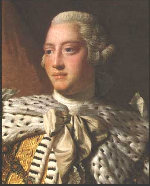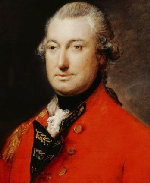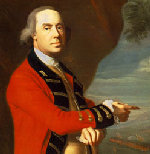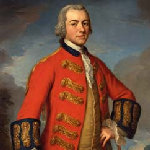The British




King George III ~ Third monarch from the House of Hanover ruled England from 1760-1820. His offenses outlined in the Declaration of Independence were many & included, imposing taxes without consent, abdicating government, plundering our seas, ravaging our coasts, burning our towns & destroying the lives of our people.
Lord Charles Cornwallis served under Gen. Sir Henry Clinton & first engaged Washington at the battle of Long Island chasing him to Pennsylvania. He often took the lead position throughout the war most notably at Brandywine, Germantown & Ft. Mercer. He also figured prominantly at the Battle of Monmouth. Not wanting to face Washington at the surrender at Yorktown, he claimed he was ill & sent Brigadier Gen. Charles O'Hara in his place. Washington in turn sent his 2nd in command Benjamin Lincoln to formally accept Cornwallis' sword.

General William Howe arrived in America in May 1775 in time to lead the British to a very costly victory at Bunker Hill. He succeeded Thomas Gage as Commander-in-Chief in September 1775. He occupied all of New York after victories at the Battles of Long Island & White Plains. In both cases he neglected to pursue the Americans which many believe could have brought an early end to the war. His decision to move on Philidelphia in 1777 rather than join Burgoyne, who was forced to surrender at Saratoga, may also have contributed to the Americans' ultimate victory. Howe always considered himself a friend of the Americans & fought out of duty rather than a belief in the cause. He resigned in 1778 complaining of inadequate support.
General Thomas Gage was Commander-in-Chief of the British forces in America 1763-1775. As Governor of the Province of Massachusetts Bay he oversaw many unpopular British policies including the Intolerable Acts implemented in response to the Boston Tea Party. His attempts to sieze caches of colonial ammunition ignited the Battles of Lexington & Concord. Blamed for the heavy casualties at Bunker Hill, he was replaced by General Howe & returned to England. His report to the Cabinet advised that "a large army must at length be employed to reduce these people" & would require "the hiring of foreign troops."
Sir Henry Clinton arrived in Boston aboard the HMS Cerberus along with Generals Howe & Burgoyne learning en route that Boston was under siege. After taking possession of New York he was promoted to Lt. General. He replaced Howe as Commander-in-Chief in 1778 & took command in Philadelphia. He decided to focus his attention on New York & led his army through New Jersey where he was intercepted by Washington at Monmouth & the two fought to a draw. He turned his attention southward & captured Savannah, GA in 1779 & Charleston, SC in 1780. He attempted to organize a relief force for Cornwallis at Yorktown but by the time he departed, Cornwallis had already surrendered. As a result, he was replaced as Commander-in-Chief by Sir Guy Carleton in 1782.
Accomplished playwright & sometimes referred to as 'Gentleman Johnny', General John Burgoyne was appointed a command whose purpose was to capture Albany & end the rebellion. He advanced his 5,000 men from Canada & became surrounded & outnumbered at Saratoga in October 1777. His defeat would prompt much needed French support. Rather than an unconditional surrender, Burgoyne agreed to a "convention" which would allow his men to return to England. At George Washington's prompting this request was revoked by Congress & Burgoyne's men were made prisoners. Burgoyne himself returned to England under great criticism & never again held active command.
General Thomas Gage 1763 - 1775
General William Howe 1775 - 1778
General Henry Clinton 1778 - 1782
Commanders-in-Chief
King George III
General Charles Cornwallis
General John Burgoyne

Click image to enlarge





